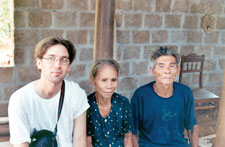Guide tells story of life in Vietnam

Stephen Harrison talked to Nguyen Phong and his wife in Vinh Moc. Phong fought against French and Americans during his time as a soldier.
Tam was my local guide for the day spent touring the DMZ. His knowledge of the region’s history was important for this excursion, but as with so many people you meet in this country, it is his personal story that brings history to life. Tam grew up in a small village near Cua Viet, just south of the dividing line between North and South Vietnam. Cua Viet is a port that was used by the U.S. to ship supplies inland along the river near his village. Prior to the 1968 Tet Offensive he had to leave home by foot as North Vietnamese Regulars (NVA) dug in nearby in preparation for battle. Tam was fourteen years old.
He traveled south along Highway One between Dong Ha and Quang Tri City, an area that soon became known as the “Highway of Terror.” Tam, among the hordes of refugees, went back and forth along the road in search of safety. But there were also Viet Cong guerrillas (VC) among them, so U.S. planes attacked relentlessly. At one point Tam stepped on a half-buried grenade on the side of the road. Luckily he only lost a couple of toes. One result was that he would not be taken into the South Vietnamese Army (ARVN).
Tam explained that he did not want to fight for either side. Like so many others in Vietnam, especially in the center of the country, he knew people on both sides. As in the American Civil War, families sometimes split over loyalties. The only concern for most of the common people, he says, was no more war. People were not interested in the politics involved. They just wanted to be able to live and work in peace. While he did not fight, he believes that the North only wanted to defeat the military and political element of the Americans and its South Vietnamese “puppet,” whereas the U.S. felt it could win with overwhelming power through destruction and body counts that included civilians.
When asked his thoughts on America today, specifically post-9/11 America, his response was one I found to hold true from Hanoi to Saigon: he is very surprised that there is so much hatred for America that innocent civilians would be targeted. Killing for any reason, he says, is bad.
The next day I visited Vinh Moc. This village, which rests on the coast of the South China Sea just north of the Seventeenth Parallel, is known for its underground tunnel system that served as a depot for weapons shipped from the north to the DMZ (see article on the Vinh Moc and Cu Chi Tunnels). An elderly couple invited me into their home under construction and provided me another amazing story of life during war in the DMZ.
Nguyen Phong is seventy years old. His wife is sixty-eight. Except during wartime he worked his whole life as a fisherman. From 1951-1954, Mr. Nguyen was a Viet Minh soldier fighting the French. As with all the other men in this village, he fought with the Youth Volunteers during the American War from 1965-1971. From 1966-1970, the women, children and elderly lived in the tunnels to avoid American bombing. They were only able to come out at night. Phong says that nobody had expectations of the bombing, or war, ending. The couple’s son, now thirty-five and living elsewhere, was one of seventeen children born in the tunnels. They also had a two-year old daughter who died in the tunnels, presumably from poor air quality.
As he looks back on the war(s), Phong says he is very proud of the job the North Vietnamese and the VC in the south did in reuniting the country. He is also proud of Ho Chi Minh. He holds no grudge with U.S. soldiers. “They were just doing what they were told to do,” he explains. Today, he likes the idea of foreigners visiting his country. As with Tam, he too says that the real enemy is war.
Your donation will support the student journalists of Missouri Southern State University. Your contribution will allow us to purchase equipment and cover our annual website hosting costs.



























